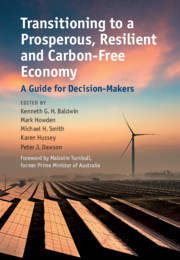Book contents
- Transitioning to a Prosperous, Resilient and Carbon-Free Economy
- Transitioning to a Prosperous, Resilient and Carbon-Free Economy
- Copyright page
- Dedication
- Contents
- Figures
- Tables
- Contributors
- Foreword
- Introduction
- 1 Policy Frameworks and Institutions for Decarbonisation: The Energy Sector as ‘Litmus Test’
- Technologies for Decarbonising the Electricity Sector
- Example Economies
- Cities and Industry
- 11 Cities
- 12 Buildings and Precincts
- 13 Urban Water
- 14 National Climate Change Adaptation Case Study: Early Adaptation to Climate Change through Climate-Compatible Development and Adaptation Pathways
- 15 Transport
- 16 Industry and Manufacturing
- Land Use, Forests and Agriculture
- Mining, Metals, Oil and Gas
- Addressing Barriers io Change
- Index
- References
13 - Urban Water
from Cities and Industry
Published online by Cambridge University Press: 08 October 2021
- Transitioning to a Prosperous, Resilient and Carbon-Free Economy
- Transitioning to a Prosperous, Resilient and Carbon-Free Economy
- Copyright page
- Dedication
- Contents
- Figures
- Tables
- Contributors
- Foreword
- Introduction
- 1 Policy Frameworks and Institutions for Decarbonisation: The Energy Sector as ‘Litmus Test’
- Technologies for Decarbonising the Electricity Sector
- Example Economies
- Cities and Industry
- 11 Cities
- 12 Buildings and Precincts
- 13 Urban Water
- 14 National Climate Change Adaptation Case Study: Early Adaptation to Climate Change through Climate-Compatible Development and Adaptation Pathways
- 15 Transport
- 16 Industry and Manufacturing
- Land Use, Forests and Agriculture
- Mining, Metals, Oil and Gas
- Addressing Barriers io Change
- Index
- References
Summary
Without progress on mitigation, the costs of adaptation to climate change will become prohibitive. The Intergovernmental Panel on Climate Change (IPCC) estimates the cost of adaptation in the water sector alone could exceed USD 50 billion/annum as droughts become more intense and frequent as well as causing more severe rainstorms, flooding and cyclones, and increasing water scarcity in cities. Climate change also risks melting glaciers and snow, upon which over 2 billion people depend for part of their water. Many urban water systems have been built without adequately factoring in the risks of climate change. These risks are already impacting cities: extreme droughts, or sewer systems overwhelmed by storms, sending raw sewage into streets, rivers and drinking water. Declining water availability risks higher energy and carbon intensity of water. This chapter gives a number of climate change mitigation strategies that also yield significant climate adaptation co-benefits and explores how pursuing these strategies can help improve sustainable development goals of improved productivity, public health, new jobs in water/energy efficiency functions and better social equity outcomes.
- Type
- Chapter
- Information
- Transitioning to a Prosperous, Resilient and Carbon-Free EconomyA Guide for Decision-Makers, pp. 338 - 364Publisher: Cambridge University PressPrint publication year: 2021

